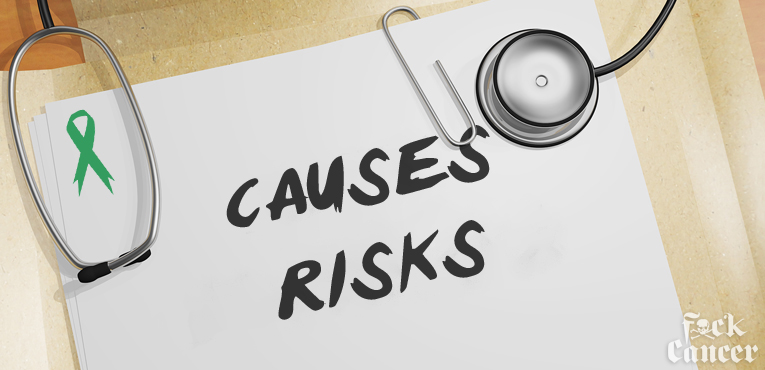
Scientists are starting to understand how risk factors like inflammation might lead to certain changes in the DNA of cells, making them grow out of control and form cancers. Researchers have also found risk factors that make a person more likely to develop gallbladder cancer.
What Causes Gallbladder Cancer?
Chronic gallbladder inflammation is a common link among many of the risk factors for gallbladder cancer. For example, when someone has gallstones, the gallbladder may release bile more slowly. This means that cells in the gallbladder are exposed to the chemicals in bile for longer than usual. This could lead to irritation and inflammation.
In another example, defects in the ducts that carry fluids from the gallbladder and pancreas to the small intestine might allow juices from the pancreas to flow backward (reflux) into the gallbladder and bile ducts. This reflux of pancreatic juices might inflame and stimulate growth of the cells lining the gallbladder and bile ducts, which might increase the risk of gallbladder cancer.
Scientists are starting to understand how risk factors like inflammation might lead to certain changes in the DNA of cells, making them grow out of control and form cancers. DNA is the chemical in each of our cells that makes up our genes, the instructions for how our cells function. We usually look like our parents because they are the source of our DNA. But DNA affects more than how we look.
- Some genes control when cells grow, divide into new cells, and die. These genes are called oncogenes.
- Genes that slow down cell division or cause cells to die at the right time are called tumor suppressor genes.
Cancer can be caused by DNA changes (mutations) that turn on oncogenes or turn off tumor suppressor genes. Changes in many different genes are usually needed for a cell to become cancer.
Some people inherit DNA mutations from their parents that greatly increase their risk for certain cancers. But inherited gene mutations are not thought to cause very many gallbladder cancers.
Gene mutations related to gallbladder cancers are usually acquired during life rather than being inherited. For example, acquired changes in the TP53 tumor suppressor gene are found in many cases of gallbladder cancer. Other genes that may play a role in gallbladder cancers include KRAS, BRAF, and PIK3CA. Some of the gene changes that lead to gallbladder cancer might be caused by chronic inflammation. But sometimes the cause of these changes is not known. Many gene changes might just be random events that sometimes happen inside a cell, without having an outside cause.
Risk Factors
A risk factor is anything that affects your chance of getting a disease such as cancer. Different cancers have different risk factors. Some risk factors, like smoking, can be changed. Others, like a person’s age or family history, can’t be changed.
But having a risk factor, or even many risk factors, doesn’t mean that a person will get the disease. And many people who get the disease may have few or no known risk factors.
Scientists have found some risk factors that make a person more likely to develop gallbladder cancer. Many of these are related in some way to chronic inflammation (long-lasting irritation and swelling) in the gallbladder.
Gallstones
Gallstones are the most common risk factor for gallbladder cancer. Gallstones are pebble-like collections of cholesterol and other substances that form in the gallbladder and can cause chronic inflammation. Up to 4 out of 5 people with gallbladder cancer have gallstones when they’re diagnosed. But gallstones are very common, and gallbladder cancer is quite rare, especially in the US. And most people with gallstones never develop gallbladder cancer.
Porcelain gallbladder
Porcelain gallbladder is a condition in which the wall of the gallbladder becomes covered with calcium deposits. It sometimes occurs after long-term inflammation of the gallbladder (cholecystitis), which can be caused by gallstones. People with this condition have a higher risk of developing gallbladder cancer, possibly because both conditions can be related to inflammation.
Female gender
In the US, gallbladder cancer occurs 3 to 4 times more often in women than in men. Gallstones and gallbladder inflammation are important risk factors for gallbladder cancer and are also much more common in women than men.
Obesity
Patients with gallbladder cancer are more often overweight or obese than people without this disease. Obesity is also a risk factor for gallstones, which might help explain this link.
Older age
Gallbladder cancer is seen mainly in older people, but younger people can develop it as well. The average age of people when they are diagnosed is 72. Most people with gallbladder cancer are 65 or older when it’s found.
Ethnicity and geography
In the US, the risk of developing gallbladder cancer is highest among Mexican and Latin Americans and Native Americans. They are also more likely to have gallstones than members of other ethnic and racial groups. The risk is lowest among African Americans. Worldwide, gallbladder cancer is much more common in India, Pakistan, and Central European and South American countries than it is in the US.
Choledochal cysts
Choledochal cysts are bile-filled sacs along the common bile duct, the tube that carries bile from the liver and gallbladder to the small intestine. (Choledochal means having to do with the common bile duct.) The cysts can grow large over time and may contain as much as 1 to 2 quarts of bile. The cells lining the sac often have areas of pre-cancerous changes, which can progress to gallbladder cancer over time.
Abnormalities of the bile ducts
The pancreas is another organ that releases fluids through a duct into the small intestine to help digestion. This duct normally meets up with the common bile duct just as it enters the small intestine. Some people have a defect where these ducts meet that lets juice from the pancreas flow backward (reflux) into the bile ducts. This backward flow also keeps bile from flowing out of the bile ducts as quickly as it should. People with these abnormalities are at higher risk of gallbladder cancer. Scientists are not sure if the increased risk is due to damage caused by the pancreatic juice or is due to the bile that can’t quickly flow through the ducts causing them to be damaged by substances in the bile itself.
Gallbladder polyps
A gallbladder polyp is a growth that bulges from the surface of the inner gallbladder wall. Some polyps are formed by cholesterol deposits in the gallbladder wall. Others may be small tumors (either cancer or not cancer) or may be caused by inflammation. Polyps larger than 1 centimeter (almost a half inch) are more likely to be cancer, so doctors often recommend removing the gallbladder in patients with gallbladder polyps that size or larger.
Primary sclerosing cholangitis
Primary sclerosing cholangitis (PSC) is a condition in which inflammation of the bile ducts (cholangitis) leads to the formation of scar tissue (sclerosis). People with PSC have an increased risk of gallbladder and bile duct cancer. The cause of the inflammation is not usually known. Many people with PSC also have ulcerative colitis, a type of inflammatory bowel disease.
Typhoid
People chronically infected with salmonella (the bacterium that causes typhoid) and those who are carriers of typhoid are more likely to get gallbladder cancer than those not infected. This is probably because the infection can cause gallbladder inflammation. Typhoid is very rare in the US.
Family history
Most gallbladder cancers are not found in people with a family history of the disease. A history of gallbladder cancer in the family seems to increase a person’s chances of developing this cancer, but the risk is still low because this is a rare disease.
Other possible risk factors
Studies have found other factors that might increase the risk of gallbladder cancer, but the links are not as clear. These include:
- Smoking
- Exposure to chemicals used in the rubber and textile industries
- Exposure to nitrosamines
Can Gallbladder Cancer Be Prevented?
There’s no known way to prevent most gallbladder cancers. Many of the known risk factors for gallbladder cancer, such as age, gender, ethnicity, and bile duct defects, are beyond our control. But there are things you can do that might help lower your risk.
Getting to and staying a healthy weight is one important way a person may reduce their risk of gallbladder cancer, as well as many other types of cancer. The American Cancer Society recommends that people try to stay at a healthy weight throughout life by being active and eating a healthy diet, with a focus on plant foods.
Since gallstones are a major risk factor, removing the gallbladders of all people with gallstones might prevent many of these cancers. But gallstones are very common, and gallbladder cancer is quite rare, even in people with gallstones. Most doctors don’t recommend people with gallstones have their gallbladder removed unless the stones are causing problems. This is because, i most cases, the possible risks and complications of surgery probably don’t outweigh the possible benefit. Still, some doctors might advise removing the gallbladder if long-standing gallstone disease has resulted in a porcelain gallbladder.
Next Blog… Early Detection, Diagnosis, and Staging
Source: American Cancer Society, Risk Factors For Gallbladder Cancer, https://www.cancer.org/cancer/gallbladder-cancer/causes-risks-prevention/risk-factors.html, July 12, 2018
Source: American Cancer Society, What Causes Gallbladder Cancer, https://www.cancer.org/cancer/gallbladder-cancer/causes-risks-prevention/causes.html, July 12, 2018
Source: American Cancer Society, Can Gallbladder Cancer Be Prevented, https://www.cancer.org/cancer/gallbladder-cancer/causes-risks-prevention/prevention.html, July 12, 2018
fuck cancer, fxck cancer, f cancer, fuck cancer foundation, fxck cancer foundation, f cancer foundation
